Gigabyte GA-Z87X-UD3H Review
Manufacturer: GigabyteUK Price (as reviewed): £148.44 (inc. VAT)
US Price (as reviewed): $159.99 (ex. Tax)
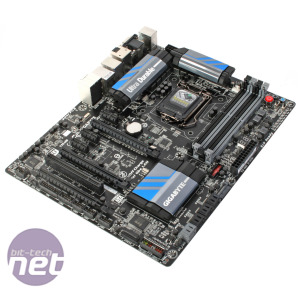
The market for Z87 motherboard is rapidly dividing on pretty clear pricing lines; the high-end, with the likes of Maximus VI Hero at around £175, the more budget focused enthusiast boards, hitting the £120 price point, and the mid-range at around £150. That latter camp is where Gigabyte’s Z87X-UD3H fits, although as we’ve found out, it offers a lot more extras than you’d expect.
With a less extravagant price and little of the extreme overclocking or ultra-performance branding of some of the competition (including Gigabyte’s own black and orange OC boards), the UD3H is rather unassuming and perhaps even a little drab in its black and grey trim, with just a splash of Gigabyte blue on the Southbridge and VRM heatsinks.
However, while the black PCB mightn’t look the flashiest, the UD3H offers a healthy stack of features that rivals many more expensive boards. There are three PCI-E 16x slots; the top two are both PCI-E 3.0 while the lower slot is PCI-E 2.0. The board supports two-card CrossFire and SLI via the PCI-E 3.0 slots. The two slots share x16 lanes of bandwidth between them: use a single card and it’ll be able to access all 16, while a pair of cards will run with both slots at x8 lanes.
The lower PCI-E 2.0 16x slot maxes out at x4 lanes of bandwidth, but this is shared with the three PCI-E 1x slots; in a worst case (and expansion-card filled) scenario, each slot will only be able to access x1 lane of PCI-E bandwidth. A legacy PCI slot rounds off the board’s expansion slots, allowing you to keep using that seven year old Creative X-fi (or Audigy! - Ed.) or TV Card. There’s also the odd addition of a dedicated SATA power connector on the side of the board to provide additional power to the PCI-E slots should you use multiple VGA or expansion cards.
Away from the expansion slots, the UD3H also boasts eight 90° angled SATA 6Gbps ports, with six supplied via the Z87 chipset and a further pair of ports courtesy of a Marvell 88SE9172 drive controller. Extra ports provided by 3rd party controller chips are typically slower than the chipset ports, so Gigabyte has helpfully colour-coded them to make it easy to avoid the more sluggish SATA.
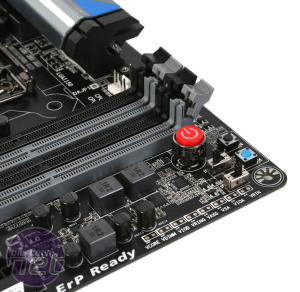
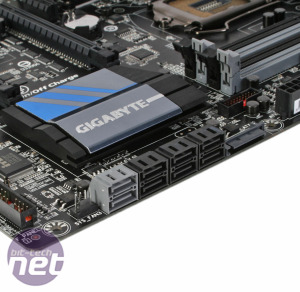
Click to enlarge - A cluster of on-board switches occupies the top right corner of the board, while an extra pair of SATA 6Gbps ports are provided via a Marvell controller
The Marvell controller isn’t wasted though, as its pair of ports can also be connected via eSATA on the rear I/O. The rear of the board also houses an Intel Gigabit network port, six chipset USB 3.0 ports and four video outputs in the form of VGA, DVI, HDMI and DisplayPort. There’s also a legacy PS2 port, an optical S/PDIF input/output and six 3.5mm jacks for the Realtek ALC898 7.1 audio controller. An array of on-board headers compliments the rear I/O, with a pair of USB 3.0 headers, each supporting a pair of USB 3.0 ports, and a trio of USB 2.0 headers.
It’s the array of board switches and buttons that impresses the most though, with the UD3H equipped with power, reset, and clear CMOS buttons in the top right corner of the board, alongside a BIOS POST-code readout The usefulness of the readout and these switches and can’t be overstated; when you’re trouble-shooting a board and having to jump pins or play guessing games with faults, it’s only a matter of time before a potentially disastrous and warranty voiding rage-quit. There’s also a Dual BIOS switch, allowing you to resurrect the board should the worst happen when updating.
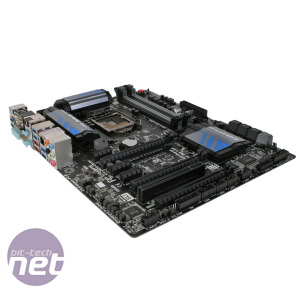
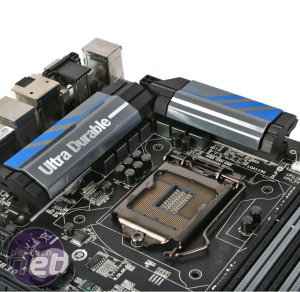
Click to enlarge - The VRM heatsinks aren't linked by a heatpipe to balance thermals, but are very closely spaced
So while it’s not too eye catching, the UD3H is very well kitted out, without going for the kitchen-sink approach to extras of so many high-end boards. It’s very well laid out too, with plenty of aforementioned 90° connectors and all the headers and power connectors right along the edge of the board. The only exception is a single 4-pin fan header (one of six) just above the array of expansion slots to power a rear cooling fan. The expansion slots themselves are arranged so that, even with a pair of dual-slot GPUs, you’ll only sacrifice a single PCI-E 1x and the legacy PCI slot and the VRM coolers are large enough to effectively dissipate heat without crowding the CPU socket.
- Chipset Intel Z87
- CPU support LGA1150 compatible
- Memory support 4 slots: max 32GB DDR3 (2,400MHz)
- Expansion slots SLI and Crossfire support, Two 16x PCI-E 3.0 slots (One at x16, two at 8x one 16x PCI-E 2.0 slot x4), three 1x PCI-E (share bandwidth with PCI-E 2.0 slot)
- Sound 7.1-channel HD audio via Realtek ALC898
- Networking Intel Gigabit Ethernet LAN
- Ports 8 x SATA 6Gbps (six via Intel Z87, two via Marvell 88SE9172 controller)10 x USB 3 (4 x via headers), 6 x USB 2 ( 6 via headers), LAN, audio out, line in, mic, optical S/PDIF in/out, HDMI, VGA, DVI, DisplayPort
- Dimensions (mm) 305 x 244 (ATX)
- [b]Extras[/b[ on-board power, reset, clear CMOS switches, LED POST-code reader, Dual-BIOS

MSI MPG Velox 100R Chassis Review
October 14 2021 | 15:04



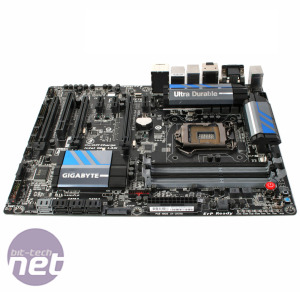







Want to comment? Please log in.